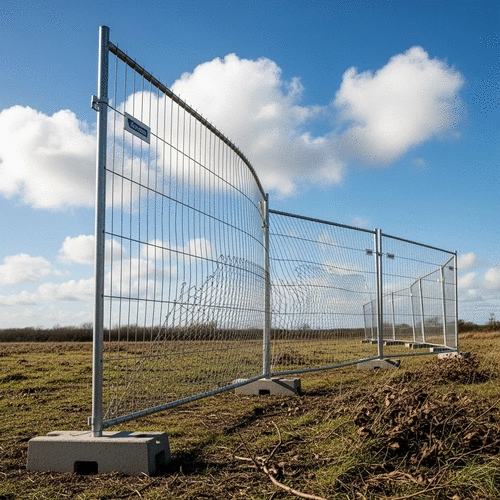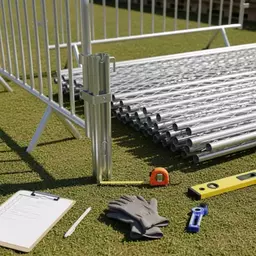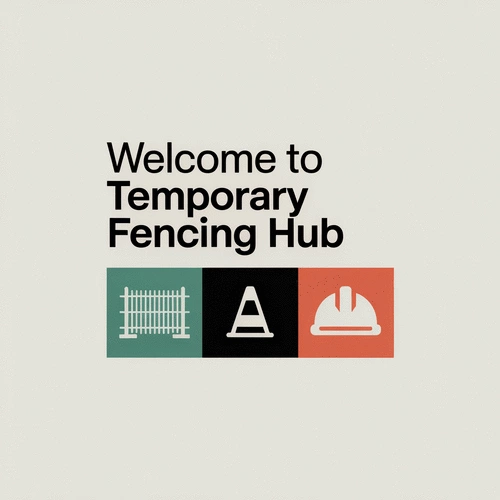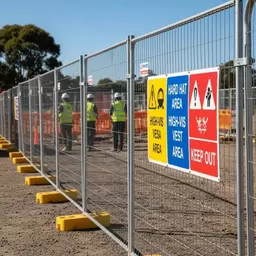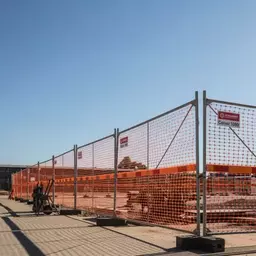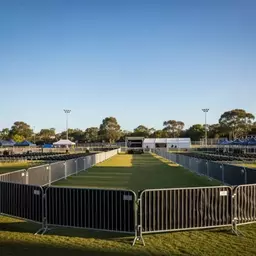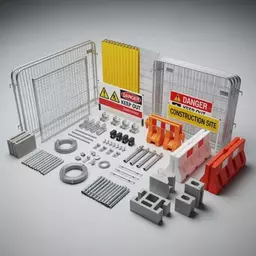What if the temporary fencing at your next event could withstand the mightiest winds? In high-wind areas, choosing the right fencing solution isn't just a preference; it's a necessity for safety and compliance.
What You Will Learn
- Temporary fencing is essential for safety in various settings, including events and construction sites.
- Understanding local weather patterns and high-wind characteristics is crucial for selecting effective fencing solutions.
- Environmental factors such as soil type and moisture levels significantly impact the stability of temporary fencing.
- Best practices for high-wind areas include using robust materials and proper anchoring systems to ensure compliance with safety standards.
- Regular inspections and maintenance of fencing can prevent failures and ensure ongoing safety during high-wind conditions.
Key Factors Affecting Temporary Fencing Stability
Understanding the critical elements that influence temporary fencing performance is essential, especially in challenging environments. The infographic below highlights the primary considerations for ensuring secure and robust fencing solutions.
Environmental Factors
- Soil composition affects anchors
- Moisture weakens materials
- Nearby structures redirect wind
High Wind Area Characteristics
- Frequent wind direction changes
- Increased gust intensity
- Geographical wind amplification
Best Practices
- Wind-rated materials
- Proper anchoring systems
- Compliance with AS 4687:2022
Site Manager's Checklist
- Evaluate site wind exposure
- Design layout with anchors
- Regular inspections & maintenance
Understanding Temporary Fencing in High-Wind Areas
When it comes to temporary fencing, understanding its role in high-wind areas is crucial. Temporary fencing serves multiple purposes, from crowd control at events to ensuring safety at construction sites. In high-wind conditions, the integrity of this fencing can be challenged, making it vital for businesses and event organizers to choose the right options that can withstand environmental pressures. For more detailed insights into ensuring proper setup, consider our guide on guidelines for event fencing setup.
At Temporary Fencing Hub, I often hear concerns from clients about how to ensure their fencing solutions remain secure and effective even in gusty weather. The importance of selecting robust materials and installation techniques cannot be overstated, as they directly contribute to the safety and success of your projects.
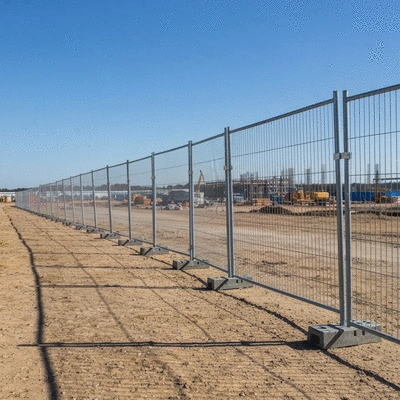
What is Temporary Fencing and Why is it Important?
Temporary fencing is a versatile solution used across various industries to create barriers and protect designated areas. Whether you're organizing an outdoor festival or managing a construction site, the right fencing keeps both people and property safe.
- Ensures safety for attendees and workers
- Provides clear boundaries for restricted areas
- Enhances security against unauthorized access
These fences are not just physical barriers; they symbolize safety and order. However, in high-wind areas, they also need to be engineered to resist powerful gusts, which can easily compromise less stable structures.
Characteristics of High-Wind Areas in Australia
Australia is known for its diverse climate, which includes regions particularly prone to high winds. Coastal areas, for example, can experience strong gusts due to their exposure to oceanic weather patterns. Understanding the specific characteristics of these regions helps in choosing the right fencing solution.
- Frequent changes in wind direction
- Increased gust intensity during storms
- Geographical features that amplify wind effects
As a business owner, I encourage clients to consider local weather patterns and historical data when selecting temporary fencing. These factors can significantly impact the performance and reliability of your fencing in challenging conditions. For comprehensive information on compliance, refer to Australian temporary fencing safety standards.
Impact of Environmental Factors on Temporary Fencing Stability
Several environmental factors directly influence the stability of temporary fencing. High winds can lead to structural failure if the fencing is not adequately designed or installed. Factors such as soil type, moisture levels, and surrounding structures play a significant role in how well a fence will hold up.
- Soil composition affects support for ground anchors
- Moisture can weaken the integrity of materials
- Nearby buildings or trees may redirect wind forces
By assessing these elements beforehand, businesses can make informed decisions that enhance the safety and durability of their temporary fencing solutions. Remember, proactive planning today can prevent costly repairs or safety violations tomorrow!
Frequently Asked Questions (FAQs)
Q1: Why is understanding high-wind areas crucial for temporary fencing?
A1: Understanding high-wind areas is crucial because temporary fencing integrity can be challenged by strong gusts, making proper selection and installation vital for safety and compliance at events and construction sites.
Q2: What key factors affect temporary fencing stability in challenging environments?
A2: Key factors include environmental elements like soil composition, moisture levels, and the presence of nearby structures that can redirect wind, as well as high-wind area characteristics such as frequent wind direction changes and increased gust intensity.
Q3: What are the best practices for securing temporary fencing in high-wind areas?
A3: Best practices include using wind-rated materials, proper anchoring systems, and ensuring compliance with Australian standards like AS 4687:2022. Regular inspections and maintenance are also essential.
Q4: What should a site manager consider when implementing temporary fencing in high-wind areas?
A4: Site managers should evaluate site-specific wind exposure, choose wind-resistant materials, design layouts with effective anchoring, verify compliance with standards, conduct risk assessments, and establish a maintenance schedule.
Q5: Where can I find more resources on Australian standards for temporary fencing?
A5: You can find more information on Australian standards from the official Standards Australia website, Safe Work Australia guidance documents, industry publications, and local council resources for region-specific regulations.
We Want to Hear From You!
In your experience, what challenges have you faced when securing temporary fencing in high-wind areas? Share your thoughts below:
Summary of Best Practices for Securing Temporary Fencing
When it comes to ensuring the safety and compliance of temporary fencing, especially in high-wind areas, there are several best practices you should keep in mind. Understanding these practices can help you make informed decisions that protect both your project and the people involved. It’s essential to prioritize wind resistance, adhere to regulations, and implement effective safety measures throughout your fencing setup.

Here’s a recap of key points that are vital for compliance and safety:
- Choose materials and designs specifically intended for high-wind conditions.
- Utilize proper anchoring systems and ground anchors to secure fencing.
- Ensure all temporary fencing meets Australian standards, particularly AS 4687:2022.
- Conduct thorough risk assessments before installation to identify potential hazards.
- Regularly inspect and maintain fencing to prevent wear and tear over time.
By following these key practices, you can significantly enhance the stability and reliability of temporary fencing in challenging environments. Remember, each step you take contributes to a safer setup!
Next Steps for Implementation
Practical Checklist for Site Managers
As a site manager, implementing effective temporary fencing requires careful planning and execution. Here's a practical checklist to guide you through the process:
- Evaluate the specific site conditions and potential wind exposure.
- Choose fencing materials that are rated for high-wind resistance.
- Design a layout that incorporates effective anchoring systems.
- Verify compliance with AS 4687:2022 and local building codes.
- Conduct a pre-installation risk assessment to identify hazards.
- Establish a maintenance schedule for regular inspections.
This checklist will help you stay organized and focused while ensuring that all necessary precautions are taken to protect your site and its personnel.
Resources for Further Guidance on Australian Standards
Staying updated on compliance and safety standards is crucial in our industry. Here are some valuable resources you can refer to for more information on Australian standards:
- The official Standards Australia website for the latest regulations.
- Guidance documents and safety guidelines provided by the Safe Work Australia.
- Industry publications that focus on temporary fencing practices and innovations.
- Local council resources for region-specific regulations and requirements.
Utilizing these resources will empower you to maintain compliance and enhance the safety of your temporary fencing setups. For additional tips related to setup, explore our article on installing fencing on slopes.
Emergency Planning and Site Inspection Protocols
Emergency preparedness is a key aspect of managing temporary fencing. Implementing effective planning and inspection protocols can help you respond swiftly to potential incidents. Here’s what to keep in mind:
- Develop an emergency response plan tailored to your specific site conditions.
- Schedule regular site inspections to assess fencing integrity and stability.
- Train staff on safety protocols and emergency procedures related to fencing.
- Ensure clear communication channels are established for reporting issues.
By focusing on these protocols, you can create a safer environment for everyone involved. Don’t overlook the importance of preparedness in your temporary fencing management strategy!
Recap of Key Points
Here is a quick recap of the important points discussed in the article:
- Choose materials and designs specifically intended for high-wind conditions to enhance stability.
- Utilize proper anchoring systems and ground anchors to secure fencing effectively.
- Ensure all temporary fencing meets Australian standards, particularly AS 4687:2022.
- Conduct thorough risk assessments before installation to identify potential hazards.
- Regularly inspect and maintain fencing to prevent wear and tear over time.

